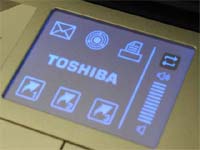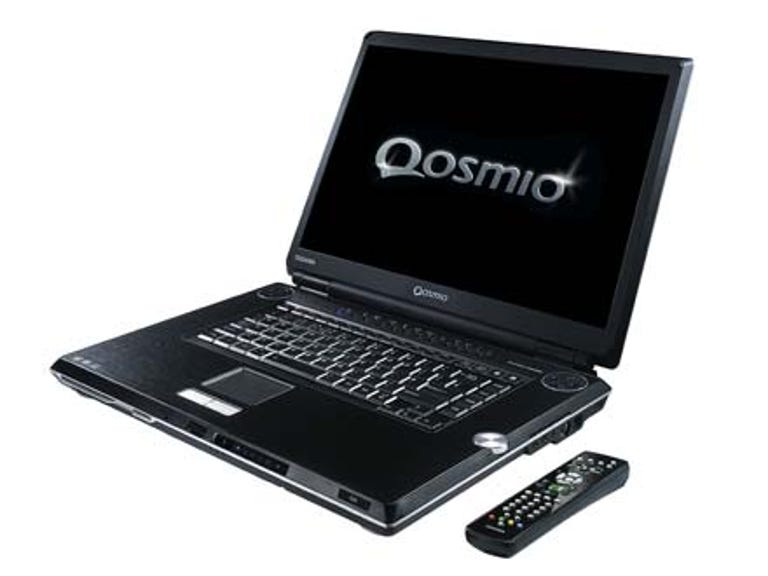 Why You Can Trust CNET
Why You Can Trust CNET Toshiba Qosmio G30 (HD DVD Edition) review: Toshiba Qosmio G30
Although the benefit of HD DVD is questionable, the Toshiba Qosmio G30 is still the most feature-rich home entertainment notebook we've seen to date.
Update (25/07/06): A Toshiba spokesperson has just informed us that the AU$4299 version of the G30 that is sold without the HD-DVD drive is no longer on the market. Please keep this in mind when making your purchasing decisions.
The Good
The Bad
The Bottom Line
Toshiba has rushed out of the gates early, adding HD DVD support to its Qosmio G30 notebook offering. This makes it both the first notebook computer to be equipped with HD DVD worldwide, as well as the first HD DVD player to reach Australian shores.
Design
Weighing in at 4.5kg and with dimensions of 406mm by 295mm by 44.7mm (50.5 mm counting its rubberised feet), the G30 is undoubtedly one of the bulkiest notebooks currently on the market. Even for a desktop replacement, it's heftier than we're used to. This should be a non-issue for most potential buyers, however.
The notebook has been designed from the ground up with home entertainment in mind. Just above the keyboard is a set of multimedia quick-launch buttons, including one to launch your TV viewing application and another for recording shows on the fly. To the right of the arrow keys lies a volume adjustment wheel, which we found to be handy despite the fact that we would've preferred it to be a little more sensitive (you'll need a full revolution just to increase volume by one notch).
Like Toshiba's Satellite Pro P100, the touchpad doubles as a bay of quick launch buttons for easy access to your most-used applications. This is designed for those using an external mouse, as in these cases the touch pad usually remains idle. Switching between the two modes is done at the tap of a button, and assigning applications to the three customisable buttons is painless.
 The touchpad doubles as a bay of quick launch buttons. |
Features
Toshiba's Qosmio G30 is being pitched as a "four-in-one entertainment unit", which symbolises its four main functions -- television, stereo audio player, HD DVD player and notebook PC.
As expected from such a high-end multimedia device, the notebook's features serve the aforementioned functions well. First off, there's a high-definition DVB-T TV tuner for watching and recording digital television. This tuner also supports analog streams should you be living in an area without digital reception.
Of course, the G30's standout feature is its HD DVD drive. For the uninitiated, HD DVD is one of the two next-generation DVD formats currently fighting it out to replace regular DVD discs (more information can be found here). The key attraction boasted by both formats is their increased capacity (Blu-ray currently comes in 25GB and 50GB flavours; HD DVD in 15GB and 30GB), enabling the storage and playback of high-definition movies at full resolution. The drive can't write to HD DVD discs, but it's able to both read and write DVD and CD discs, including dual-layer and DVD-RAM.
One factor that will undoubtedly hinder the take-up of HD DVD devices is the fact that HD DVD content/media is currently non-existent in the Australian market, and there are no firm dates as to when it will arrive. Of course, keen early adopters can order content from US outlets over the internet. Additionally, HD DVD is compatible with the current DVD format, so users can continue using the device like a regular DVD player until HD-DVD discs arrive.
A notebook PC isn't always ideal for watching TV and DVDs, especially if you're with a group of people. With that in mind, Toshiba has fitted the unit with a slew of connectivity options for hooking it up to a big screen TV, including HDMI, S-Video (in and out) and D-Sub. It's the first notebook we've seen that includes a HDMI connector -- very impressive! Don't worry if you don't have a huge TV, the 17-inch 1920x1080 widescreen display (featuring two lamps for increased colour saturation) is superb for solo viewing. Additionally, if you'd like to hook up any external devices, composite inputs with left and right audio jacks are also included.
The G30's audio hardware is equally impressive. It uses the Intel High Definition Audio integrated chipset (with Dolby certification), boasts a 1-Bit digital amp -- a world first, according to Toshiba -- and finally, it also includes a pair of Harman/Kardon integrated stereo speakers.
All of the notebook's entertainment features can be accessed from the comfort of your couch using a seamless interface, thanks to Toshiba's choice of operating system -- Windows Media Center Edition 2005 -- and its inclusion of a handy remote control.
The notebook is based on Intel's Centrino Duo platform. Under the hood lies a 2.16GHz Intel Core Duo T2600 processor, 1GB of DDR2-533 memory, two 100GB hard drives and an Nvidia GeForce 7600 graphics chip. All of the major wireless standards are supported, including 10/100/1000 (Gigabit) LAN, 802.11a/b/g Wi-Fi and Bluetooth 2.0.
According to Toshiba, the G30 is also one of the first notebooks to be fully compatible with Windows Vista (however, Microsoft has yet to confirm final hardware specifications).
Performance
HD DVD vs. DVD
Without a doubt the main question we had going into this review was: is there a noticeable quality difference between HD DVD and DVD? Fortunately, after conducting a throng of benchmarks, we're now able to answer that question. HD DVD offers a noticeable increase in quality over DVD, provided that your display can project the full 1080 lines of resolution. The G30's display offers a native resolution of 1920x1080, so it can display HD DVD content without shrinkage.
The only HD-DVD movie we could get our hands on to conduct our tests was "Rumour Has It...". This proved ideal, since the double-sided disc provides both DVD and HD DVD versions of the same movie, allowing us to compare the two formats head-to-head. On the notebook's own display, we found there is a perceivable increase in detail when moving to the HD version, and that this is particularly noticeable in extreme close-ups of faces. We wouldn't call it significantly better, but the difference is tangible.
To give you a visual depiction of the difference between HD DVD and DVD, below is a screenshot from the film under both formats. The regular image is of the DVD version, while hovering your mouse over the image will activate the HD DVD image. Since current HD DVD players do not allow for still-image screenshots to be taken, we were forced to use a digital camera and a tripod to obtain both shots.
The full resolution versions of both screenshots can be found here (DVD) and here (HD DVD).
Aside from the fact that you'll need a high-resolution TV set, there are two other factors weighing against HD DVD. The first is that the AU$5499 price tag becomes AU$4299 when you swap the HD DVD drive for a regular DVD writer -- AU$1200 is a significant premium given that the quality difference isn't mammoth. Secondly, the format war between HD DVD and Blu-ray is far from over, and it's uncertain whether or not one or both standards will be dead a year from now.
If we were to purchase the G30 today, we'd unflinchingly buy it without the HD DVD drive.
Office Productivity & Gaming
The G30's speedy internal components will have no issues handling your office productivity tasks. Using MobileMark2005, we recorded a very impressive productivity score of 245, which trumps most other notebooks we've tested.
BAPCo MobileMark2005 performance rating
(Longer bars indicate better performance)
It also handled the gaming applications we threw at it admirably, including Doom 3 with all eye candy settings turned up to maximum.
Battery Life
Battery life is never a desktop replacement's strong point, and the G30 is far from an exception to this rule. We recorded a battery life score of 108 minutes, so you won't even get through an entire DVD unless you're plugged into a power outlet. We're not going to hold this against Toshiba, since portability is rarely a factor when purchasing a desktop replacement notebook.
BAPCo MobileMark2005 battery life rating
(Longer bars indicate more battery-life minutes)
Although the benefit of HD DVD is questionable, the Toshiba Qosmio G30 is still the most feature-rich home entertainment notebook we've seen to date.
